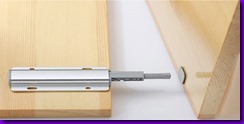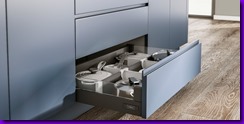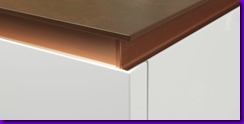 Fitted kitchens without a visible handle are becoming increasingly popular especially in smaller kitchens when handles can sometimes make the kitchen look too busy. The question often asked is how do we achieve the handleless look in a practical way? The answer is that there are several ways to design a kitchen without handles and the three most popular are as follows:-
Fitted kitchens without a visible handle are becoming increasingly popular especially in smaller kitchens when handles can sometimes make the kitchen look too busy. The question often asked is how do we achieve the handleless look in a practical way? The answer is that there are several ways to design a kitchen without handles and the three most popular are as follows:-
Push/touch to open – In our experience this is the least practical solution to making a kitchen handleless. Each of the doors and drawers are fitted with a mechanism that enables the user to push lightly on the the door/drawer and it will spring open. The downside to this option is that the mechanism will not work with integrated appliances therefore a discrete handle would have to be fitted instead and this slightly defeats the object of the exercise. The other thing to bear in mind when considering this option is that mechanical openers tend to break down at some point and you may have to replace them in the future.
 The `J’ Door – This is the most practical way of achieving the sleek handleless look. The ‘J’ door is so called because the top/bottom of the door is cut out in the shape of a J creating a finger grip. The advantage of the J door system is that any unit will take a J door so there are no restrictions concerning the design of the kitchen. The only thing to be aware of when looking to purchase this style is the thickness of the door used, ideally, you should be looking at a 22m thick door which gives a wider finger grip and makes the weak point of the door stronger and less vulnerable to snapping, a cheaper 18mm thick option might create the same look but will certainly be more of a risk and less comfortable to open.
The `J’ Door – This is the most practical way of achieving the sleek handleless look. The ‘J’ door is so called because the top/bottom of the door is cut out in the shape of a J creating a finger grip. The advantage of the J door system is that any unit will take a J door so there are no restrictions concerning the design of the kitchen. The only thing to be aware of when looking to purchase this style is the thickness of the door used, ideally, you should be looking at a 22m thick door which gives a wider finger grip and makes the weak point of the door stronger and less vulnerable to snapping, a cheaper 18mm thick option might create the same look but will certainly be more of a risk and less comfortable to open.
 The Rail System – This is the style that most people associate with the true handleless system and is seen more often than not in German style kitchens. It is the most expensive option and usually suits galley kitchens or kitchens with the space to have an island and a bank of tall units. The handleless effect is achieved by adding a metal top, middle or side rail to all the cabinets creating a gap to allow for fingers. The end result is a very sleek, linear look but there are lots of components to account for and heights of built under appliances can be an issue if the cabinets have not been made taller to account for the top rail. It is certainly a wise move to seek a designer to help you plan this style of kitchen.
The Rail System – This is the style that most people associate with the true handleless system and is seen more often than not in German style kitchens. It is the most expensive option and usually suits galley kitchens or kitchens with the space to have an island and a bank of tall units. The handleless effect is achieved by adding a metal top, middle or side rail to all the cabinets creating a gap to allow for fingers. The end result is a very sleek, linear look but there are lots of components to account for and heights of built under appliances can be an issue if the cabinets have not been made taller to account for the top rail. It is certainly a wise move to seek a designer to help you plan this style of kitchen.
Handleless kitchens can really make a big difference to your space and hopefully the above information will help you choose the right product for you. We are always at hand in our showroom to give you more insights into the options that are available for any style of kitchen you are looking for, so why not pay us a visit. Live Well, Buy Well.
